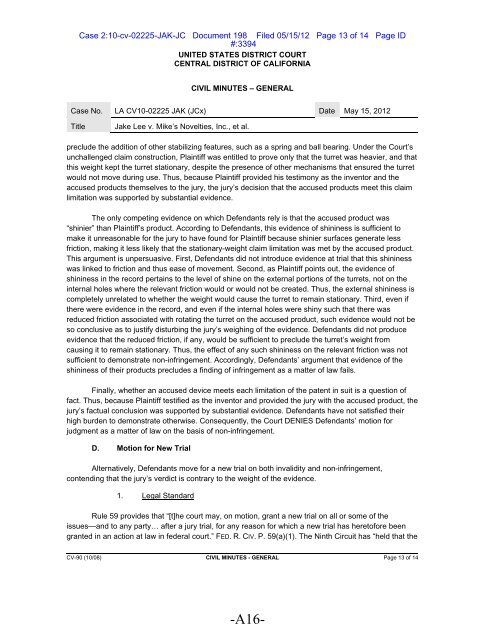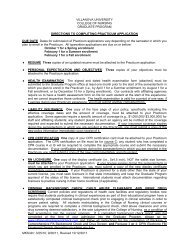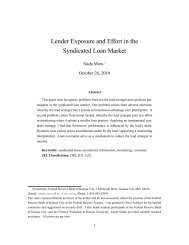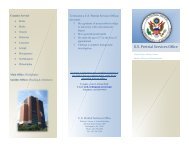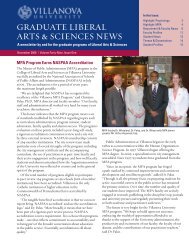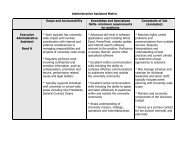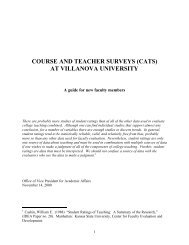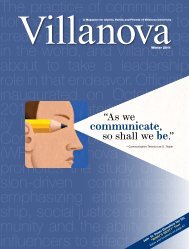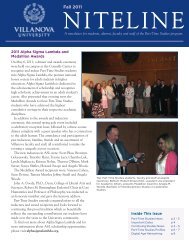- Page 1 and 2: DOCKET NUMBER 2013-1049UNITED STATE
- Page 3 and 4: U.S. Patent No. 682,278issued on Se
- Page 5 and 6: Notice of Reassignment of CaseDue t
- Page 7 and 8: Case 2:10-cv-02225-JAK-JC Document
- Page 9 and 10: Case 2:10-cv-02225-JAK -JC Document
- Page 11 and 12: Case 2:10-cv-02225-JAK-JC Document
- Page 13 and 14: Case 2:10-cv-02225-JAK-JC Document
- Page 15 and 16: Case 2:10-cv-02225-JAK-JC Document
- Page 21: Case 2:10-cv-02225-JAK-JC Document
- Page 25 and 26: Case 2:10-cv-02225-JAK-JC Document
- Page 27 and 28: Case 2:10-cv-02225-JAK-JC Document
- Page 29 and 30: Case 2:10-cv-02225-JAK-JC Document
- Page 31 and 32: Case 2:10-cv-02225-JAK-JC Document
- Page 33 and 34: Case 2:10-cv-02225-JAK-JC Document
- Page 35 and 36: Case 2:10-cv-02225-JAK-JC Document
- Page 37 and 38: Case 2:10-cv-02225-JAK-JC Document
- Page 39 and 40: Case 2:10-cv-02225-JAK -JC Document
- Page 41 and 42: Case 2:10-cv-02225-JAK -JC Document
- Page 43 and 44: Case 2:10-cv-02225-JAK -JC Document
- Page 45 and 46: Case 2:10-cv-02225-JAK -JC Document
- Page 47 and 48: Case 2:10-cv-02225-JAK -JC Document
- Page 49 and 50: Case 2:10-cv-02225-JAK -JC Document
- Page 51 and 52: Case 2:10-cv-02225-JAK -JC Document
- Page 53 and 54: Case 2:10-cv-02225-JAK -JC Document
- Page 55: Case 2:10-cv-02225-JAK -JC Document
- Page 58 and 59: Case 2:10-cv-02225-JAK -JC Document
- Page 60 and 61: Case 2:10-cv-02225-JAK -JC Document
- Page 62 and 63: Case 2:10-cv-02225-JAK -JC Document
- Page 64 and 65: Case 2:10-cv-02225-JAK -JC Document
- Page 66 and 67: Case 2:10-cv-02225-JAK -JC Document
- Page 68 and 69: Case 2:10-cv-02225-JAK -JC Document
- Page 70 and 71: Case 2:10-cv-02225-JAK -JC Document
- Page 72 and 73:
Case 2:10-cv-02225-JAK -JC Document
- Page 74 and 75:
Case 2:10-cv-02225-JAK -JC Document
- Page 76 and 77:
Case 2:10-cv-02225-JAK -JC Document
- Page 78 and 79:
Case 2:10-cv-02225-JAK -JC Document
- Page 80 and 81:
Case 2:10-cv-02225-JAK -JC Document
- Page 82 and 83:
Case 2:10-cv-02225-JAK -JC Document
- Page 84 and 85:
Case 2:10-cv-02225-JAK -JC Document
- Page 86 and 87:
Case 2:10-cv-02225-JAK -JC Document
- Page 88 and 89:
Ca e 10-cv-02·225-JAK -JC Document
- Page 90 and 91:
e 2:1 1 1 1 4 7 ID #:12345678910111
- Page 92:
Ca e 2:1 O-cv-02225-JAK -JC Documen
- Page 95 and 96:
U.S. U.8. Patent Jul. Jui. 16,2002
- Page 97 and 98:
US 6,418,936 B1 Bl12TOBACCO PIPEwei
- Page 99 and 100:
US 6,418,936 B1 Bl5 6another along
- Page 101 and 102:
UNITED STATES PATENT AND TRADEMARK
- Page 103 and 104:
UNITED STATES PATENT AND TRADEMARK
- Page 105 and 106:
"UNITED STATES PATENT OFFICE. OFFIC
- Page 107 and 108:
United States Patent [19]Locke[ll]
- Page 109 and 110:
4,171,70312is provided that include
- Page 111 and 112:
No. 682,218. 682,278.(No Model.)G.
- Page 113 and 114:
2 682,278members are fitted in thoc
- Page 115 and 116:
P,ITENTED P ;\TENTED FEB . 41915 41
- Page 117 and 118:
33,863,649the end of the stem piece
- Page 119 and 120:
United States Patent [19] £19JFari
- Page 121 and 122:
4,193,41112OBJECTS AND ADVANTAGES O
- Page 123 and 124:
4,193,411562. A smoking device as r
- Page 125 and 126:
u.s. U.S. PatentApr. 1, 19864,579,1
- Page 127 and 128:
34,579,128larly the end of the leng
- Page 129 and 130:
Case: 2:10-cv-02225-JAK-JC As of: 0
- Page 131 and 132:
Case: 2:10-cv-02225-JAK-JC As of: 0
- Page 133 and 134:
Case: 2:10-cv-02225-JAK-JC As of: 0
- Page 135 and 136:
Case: 2:10-cv-02225-JAK-JC As of: 0
- Page 137:
Case: 2:10-cv-02225-JAK-JC As of: 0
- Page 140 and 141:
Case: 2:10-cv-02225-JAK-JC As of: 0
- Page 142 and 143:
Case: 2:10-cv-02225-JAK-JC As of: 0
- Page 144 and 145:
Case: 2:10-cv-02225-JAK-JC As of: 0
- Page 146 and 147:
Case: 2:10-cv-02225-JAK-JC As of: 0
- Page 148 and 149:
--..F'f"Case 2:10-cv-02225-VBF -JC
- Page 150 and 151:
Case 2:10-cv-02225-VBF -JC Document
- Page 152 and 153:
Case 2:10-cv-02225-VBF -JC Document
- Page 154 and 155:
Case 2:10-cv-02225-VBF -JC Document
- Page 156 and 157:
. ----.. ----,10345678910116) 63r.,
- Page 158 and 159:
12etal pipe of claim 9 including3a
- Page 160 and 161:
:'14345678910116J\tl12U1 13'J C)14p
- Page 162 and 163:
.·DETAILED ACTIONDrawingsThe drawi
- Page 164 and 165:
2) Claims 1-3, 8,11 and 18 are reje
- Page 166 and 167:
Claims 4-7, 12-17, 19 and 20 would
- Page 168 and 169:
Application No.Applicant(s)Intervie
- Page 170 and 171:
turret heavier than the manifold to
- Page 172 and 173:
Case 2:10-cv-02225-VBF -JC Document
- Page 174 and 175:
Case 2:10-cv-02225-VBF -JC Document
- Page 176 and 177:
Case 2:10-cv-02225-VBF -JC Document
- Page 178 and 179:
Case 2:10-cv-02225-VBF -JC Document
- Page 180 and 181:
Case 2:10-cv-02225-VBF -JC Document
- Page 182 and 183:
Case 2:10-cv-02225-VBF -JC Document
- Page 184 and 185:
Case 2:10-cv-02225-VBF -JC Document
- Page 186 and 187:
Case 2:10-cv-02225-VBF -JC Document
- Page 188 and 189:
Case 2:10-cv-02225-VBF -JC Document
- Page 190 and 191:
Case 2:10-cv-02225-VBF-JC Document
- Page 192 and 193:
Case 2:10-cv-02225-VBF-JC Document
- Page 194 and 195:
Patent Local Rules3. PATENT DISCLOS
- Page 196 and 197:
Patent Local Rules(a) The identity
- Page 198 and 199:
Case 2:10-cv-02225-VBF-JC Document
- Page 200 and 201:
Case 2:10-cv-02225-VBF-JC Document
- Page 202 and 203:
Case 2:10-cv-02225-VBF-JC Document
- Page 204 and 205:
12345678910111213141516171819202122
- Page 206 and 207:
12345678910111213141516171819202122
- Page 208 and 209:
EXHIBITCCLAIM CHART OF DEFENDANTS'
- Page 210 and 211:
smoking said pipe.9. The metal pipe
- Page 212 and 213:
-PLAINTIFF 000265-A206-
- Page 214 and 215:
00PLAINTIFF 000267-A208-
- Page 216 and 217:
00PLAINTIFF 000269-A210-
- Page 218 and 219:
12345678910111213141516171819202122
- Page 220 and 221:
12345678910111213141516171819202122
- Page 222 and 223:
12345678910111213141516171819202122
- Page 224 and 225:
12345678910111213141516171819202122
- Page 226 and 227:
12345678910111213141516171819202122
- Page 228 and 229:
EXHIBIT A-A222-
- Page 230 and 231:
EXHIBIT B-A224-
- Page 232 and 233:
EXHIBIT C-A226-
- Page 234 and 235:
CLAIM 2CLAIM 3The metal tobacco pip
- Page 236 and 237:
Case 2:10-cv-02225-VBF -JC Document
- Page 238 and 239:
Case 2:10-cv-02225-VBF -JC Document
- Page 240 and 241:
Case 2:10-cv-02225-VBF -JC Document
- Page 242 and 243:
Case 2:10-cv-02225-VBF -JC Document
- Page 244 and 245:
Case 2:10-cv-02225-VBF -JC Document
- Page 246 and 247:
Case 2:10-cv-02225-VBF -JC Document
- Page 248 and 249:
Case 2:10-cv-02225-VBF -JC Document
- Page 250 and 251:
Case 2:10-cv-02225-VBF -JC Document
- Page 252 and 253:
Case 2:10-cv-02225-VBF -JC Document
- Page 254 and 255:
Case 2:10-cv-02225-VBF -JC Document
- Page 256 and 257:
Case 2:10-cv-02225-VBF -JC Document
- Page 258 and 259:
Case 2:10-cv-02225-JAK -JC Document
- Page 260 and 261:
Case 2:10-cv-02225-JAK -JC Document
- Page 262 and 263:
Case 2:10-cv-02225-JAK -JC Document
- Page 264 and 265:
Case 2:10-cv-02225-JAK -JC Document
- Page 266 and 267:
Case 2:10-cv-02225-JAK 2:10-cv-0222
- Page 268 and 269:
Case 2:10-cv-02225-JAK 2:10-cv-0222
- Page 270 and 271:
Case 2:10-cv-02225-JAK 2:10-cv-0222
- Page 272 and 273:
Case 2:10-cv-02225-JAK -JC Document
- Page 274 and 275:
Case 2:10-cv-02225-JAK -JC Document
- Page 276 and 277:
Case 2:10-cv-02225-JAK -JC Document
- Page 278 and 279:
Case 2:10-cv-02225-JAK -JC Document
- Page 280 and 281:
Case 2:10-cv-02225-JAK -JC Document
- Page 282 and 283:
Case 2:10-cv-02225-JAK -JC Document
- Page 284 and 285:
Case 2:10-cv-02225-JAK -JC Document
- Page 286 and 287:
Case 2:10-cv-02225-JAK -JC Document
- Page 288 and 289:
Case 2:10-cv-02225-JAK -JC Document
- Page 290 and 291:
Case 2:10-cv-02225-JAK -JC Document
- Page 292 and 293:
Case 2:10-cv-02225-JAK -JC Document
- Page 294 and 295:
Case Case 2:10-cv-02225-JAK -JC -JC
- Page 296 and 297:
Case 2:10-cv-02225-JAK -JC -JC Docu
- Page 298 and 299:
Case 2:10-cv-02225-JAK -JC -JC Docu
- Page 300 and 301:
Case 2:10-cv-02225-JAK -JC -JC Docu
- Page 302 and 303:
Case 2:10-cv-02225-JAK -JC -JC Docu
- Page 304 and 305:
Case 2:10-cv-02225-JAK -JC Document
- Page 306 and 307:
Case 2:10-cv-02225-JAK -JC Document
- Page 308 and 309:
Case 2:10-cv-02225-JAK -JC Document
- Page 310 and 311:
Case 2:10-cv-02225-JAK -JC Document
- Page 312 and 313:
Case 2:10-cv-02225-JAK -JC Document
- Page 314 and 315:
Case 2:10-cv-02225-JAK -JC Document
- Page 316 and 317:
Case 2:10-cv-02225-JAK -JC Document
- Page 318 and 319:
Case 2:10-cv-02225-JAK -JC Document
- Page 320 and 321:
Case 2:10-cv-02225-JAK -JC Document
- Page 322 and 323:
Case 2:10-cv-02225-JAK -JC Document
- Page 324 and 325:
Case 2:10-cv-02225-JAK -JC Document
- Page 326 and 327:
Case 2:10-cv-02225-JAK -JC Document
- Page 328 and 329:
Case 2:10-cv-02225-JAK -JC Document
- Page 330 and 331:
Case 2:10-cv-02225-JAK -JC Document
- Page 332 and 333:
Case 2:10-cv-02225-JAK -JC Document


